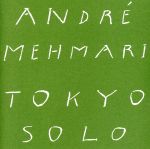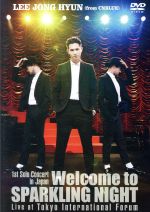

Please read the item description carefully as the item photos may not match the actual product. View original page


¥ 0
( ≈ -- )¥ 0

Check out the same item from other (3) stores
View| ジャンル | Jazz, Music Video & Concerts |
| コントリビュータ | Keith Jarrett |
| 言語 | 英語 |
| ディスク枚数 | 1 |
| 出版日 | 2006/6/6 |
詳細情報
| アスペクト比 : | 1.33:1 |
| メーカーにより製造中止になりました : | いいえ |
| 言語 : | 英語 |
| 製品サイズ : | 14.1 x 1.2 x 18.9 cm; 0.28 g |
| EAN : | 0602498731864, 0060249873186 |
| 商品モデル番号 : | B000672309 |
| 発売日 : | 2006/6/6 |
| 出演 : | Keith Jarrett |
| 言語 : | 無条件 (Dolby Digital 5.1) |
| 販売元 : | New Note |
| ASIN : | B000F2C8EY |
| ディスク枚数 : | 1 |
Amazonより
It's no bulletin that improvisation is perhaps the central component of jazz, or that Keith Jarrett, a master jazz pianist, is also a gifted improviser. Yet what Jarrett plays in the course of Tokyo Solo, a 2002 performance that was his 150th concert in Japan, could hardly be called jazz, at least not according to most accepted criteria; the music heard here is, as Duke Ellington once said, "beyond category." What's more, "improvisation" seems inadequate for the process Jarrett has been perfecting since he began making solo recordings in the early 1970s. "Spontaneous composition" is more like it, for while most jazz players extemporize over a known melody or set of changes, Jarrett begins with a tabula rasa, creating music from nothing other than what's in his head and hands at a given moment. It's a fascinating process to witness, and if Tokyo Solo is not his finest work, it's nonetheless filled with extraordinary moments. It's easy to see why Jarrett, a notorious perfectionist, has performed so often in Japan: the venues are acoustically superb, the audiences are quiet and reverent, and the resulting recordings, including this one, feature impeccable aural and visual production values. Some of the material here appeared previously on the ECM CD Radiance (2005). In the course of two lengthy pieces ("Part 1" has three sections; "Part 2" has five), Jarrett's music is sometimes dissonant and challenging, filled with furious chording and dense clusters of sound ("Part 1(a)"), sometimes classical ("Part 1(b)" brings to mind a Beethoven sonata), sometimes gorgeous and almost impressionistic ("Part 2(a)" suggests a Ravel etude, while "Part 2(d)," perhaps the most sublime portion of the concert, leans a bit more toward Debussy). The setting (a darkened stage with nothing but the pianist and his Steinway) is simple, as is Kaname Kawachi's direction; there are plenty of close-ups of Jarrett's face, hands, and feet, as well as a few shots inside the piano, but nothing in the way of effects or trickery. Three more standard encores, including "Danny Boy" and "Old Man River," complete a concert sure to be treasured by Jarrett devotees. --Sam Graham
Related Items

東京西川 枕 ファインクオリティ フワリーヌわた枕 やわらかめ ワイドサイズ 70×43cm FA6010 EFA2281010 ファインスムーズ ファインスムース
¥ 17,600

Tokyo Solo
¥ 1,430

Solo in TOKYO “Harmonics"
¥ 3,960

期間限定ポイント5倍『トーキョーハイウェイ ソロ』itten イッテンTOKYO HIGHWAY SOLO ボードゲーム
¥ 1,100

Moreno Veloso Solo in Tokyo
¥ 1,760

Love Dance〜Solo Live at Galerie de Cafe 伝 Tokyo 1987-1997
¥ 10,000

【中古】 Tokyo Solo/アンドレ・メマーリ
¥ 1,573

ゲームCD TOKYO SOLO COLLECTION -3rdLIVE TOUR PIECE ON PLANET-/シャニマス
¥ 594

THE IDOLM@STER SHINY COLORS SOLO COLLECTION -3rdLIVE TOUR PIECE ON PLANET / TOKYO-
¥ 585

THE IDOLM@STER SHINY COLORS SOLO COLLECTION -3rdLIVE TOUR PIECE ON PLANET / TOKYO-
¥ 667

【中古】【2CD】THE IDOLM@STER SHINY COLORS SOLO COLLECTION −3rdLIVE TOUR PIECE ON PLANET/TOKYO− / シャイニーカラーズ
¥ 1,113

山田裕貴ファースト写真集 山田裕貴 First Solo Photo Book-(TOKYO NEWS MOOK)
¥ 770

THE IDOLM@STER SHINY COLORS SOLO COLLECTION -3rdLIVE TOUR PIECE ON PLANET / TOKYO-
¥ 540

1st Solo Concert in Japan ~Welcome to SPARKLING NIGHT~ Live at Tokyo International Forum
¥ 792

Copyright © 2015-2024 doorzo.com, All Rights Reserved
Shipping Calculator
New Users‘ Guide
FAQ
Customer Ticket
Customer Support



























